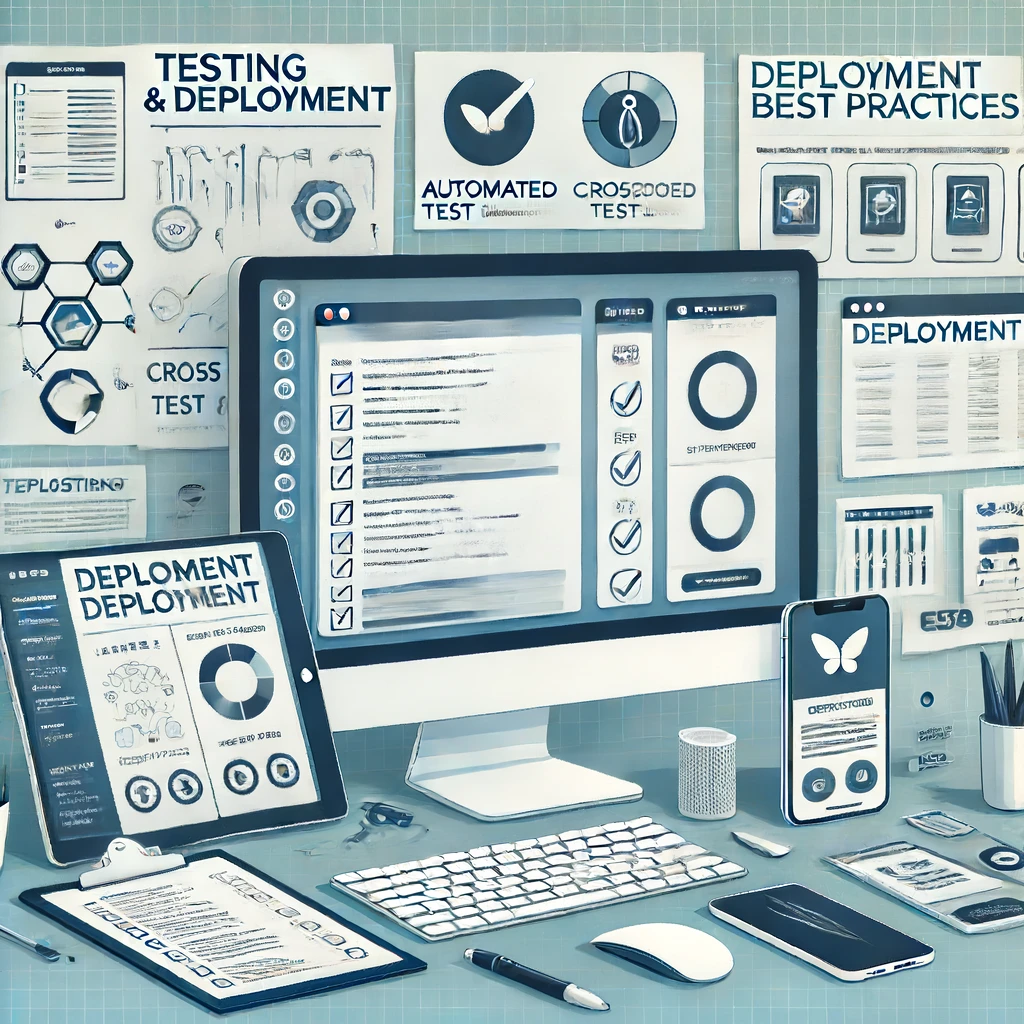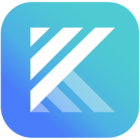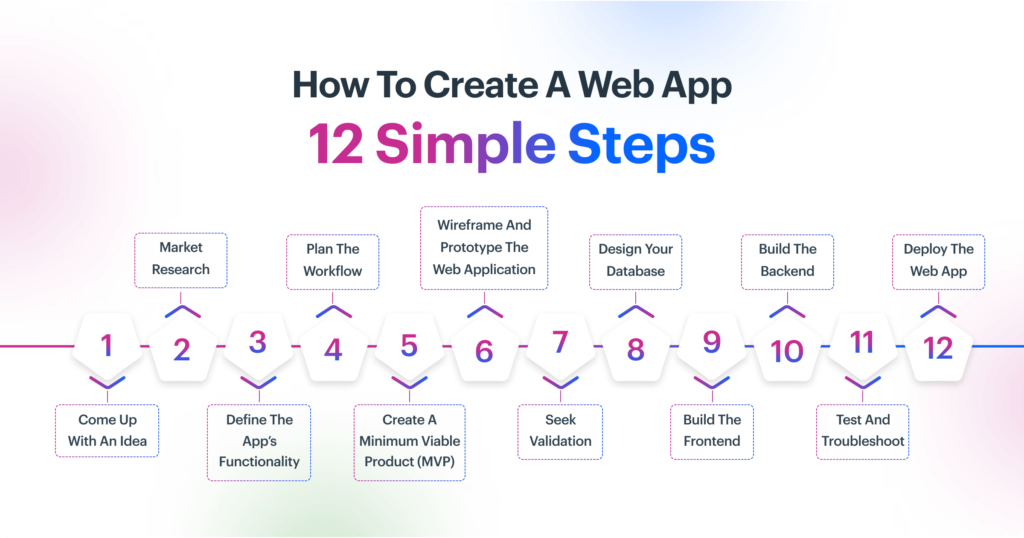
Introduction on the Development Process For How to create a Web App
The common question of How to create a Web App is always where one begins. Creating a web app can seem like a daunting task, but with the right approach and tools, it becomes a manageable and rewarding process. In this guide, we will walk you through each step of developing a web app, from planning and choosing the right technology stack to development, testing, and deployment. Whether you’re a beginner or an experienced developer, this guide will provide you with the knowledge and resources you need to create a successful web application in 2024.
Understanding Web Apps
Web applications are dynamic websites combined with server-side programming that provide functionalities such as interacting with users, connecting to back-end databases, and generating results to browsers. Unlike traditional websites, web apps allow users to perform tasks like sending emails, editing documents, or managing projects directly within their browser.
Benefits of Web Apps
Web apps offer numerous advantages, including accessibility from any device with an internet connection, automatic updates without user intervention, and improved collaboration capabilities. They are also typically more cost-effective to develop and maintain compared to native apps for multiple platforms.
Planning Your Web App
Before diving into development, it’s crucial to plan your web app thoroughly. This phase involves defining the goals and features of your application, as well as creating a visual representation of the user interface.
Defining Goals and Features
Start by identifying the primary purpose of your web app. What problem does it solve, or what value does it provide to users? Outline the core features and functionalities that will support this purpose. Consider creating user personas to better understand the needs and behaviors of your target audience.
Defining the goals and features of your web app is the foundation of your development journey. Clear objectives help you stay focused and ensure that every development decision aligns with your end goal.
Here are some tips to help you define your goals and features:
- Identify the Problem: Determine the problem your app will solve or the value it will provide to users.
- Target Audience: Understand who your users are, what they need, and how your app can meet those needs.
- Core Features: List the essential features that your app must have to fulfill its purpose.
- User Experience: Think about the user journey and how you want users to interact with your app.
Creating a Wireframe
A wireframe is a simple visual guide that represents the skeletal framework of your web app. It helps you plan the layout and navigation of your app before moving on to more detailed design and development. Use tools like Sketch, Figma, or Adobe XD to create your wireframe, focusing on user experience and ease of use.
Creating a wireframe is a crucial step in the web app planning process. It allows you to visualize the structure of your app and make necessary adjustments before diving into detailed design and development. A well-crafted wireframe serves as a blueprint for your project and ensures that everyone involved has a clear understanding of the app’s layout and functionality.
Wireframing Best Practices
Creating a detailed wireframe is an essential step in the planning process of web app development. It provides a visual representation of the structure and layout of your app, helping you and your team understand how users will interact with it. Here’s a more in-depth look into wireframing:
Tools for Wireframing
Using the right tools can make wireframing more efficient and effective. Some popular wireframing tools include:
- Sketch: A versatile tool for creating wireframes, prototypes, and high-fidelity designs.
- Figma: An online tool that allows real-time collaboration, making it ideal for teams.
- Adobe XD: Provides a comprehensive set of features for wireframing, prototyping, and sharing designs.
Key Elements of a Wireframe
A wireframe typically includes several key elements that outline the basic structure of your web app:
- Header: Contains the logo, navigation menu, and possibly a search bar.
- Footer: Includes links to important pages, contact information, and social media icons.
- Sidebar: Used for additional navigation or displaying supplementary information.
- Main Content Area: The central part of the wireframe where the primary content is displayed.
- Call-to-Action (CTA) Buttons: Buttons that encourage users to take specific actions, such as signing up or making a purchase.
Best Practices for Creating Wireframes
- Keep It Simple: Start with low-fidelity wireframes that focus on the layout and structure without getting bogged down in details.
- Focus on Functionality: Ensure that the wireframe represents the functional aspects of the app, like navigation flow and user interactions.
- Iterate and Test: Share your wireframes with team members and potential users to gather feedback and make necessary adjustments.
- Use Placeholder Text and Images: Indicate where text, images, and other content will go without creating the actual content yet.
- Document Everything: Keep detailed notes on each part of the wireframe to explain your design decisions and functionality.
Choosing the Right Technology Stack
Selecting the appropriate technology stack is crucial for the success of your web app. The technology stack includes the front-end and back-end technologies that you will use to build your application.
Front-End Technologies
The front-end, or client-side, is what users interact with directly. Popular front-end technologies include:
- HTML: The standard markup language for creating web pages.
- CSS: Used to style and layout web pages.
- JavaScript: A programming language that allows you to create dynamically updating content.
- JavaScript Frameworks: Frameworks like React, Angular, and Vue.js help streamline the development process by providing pre-built components and tools.
Choosing a Front-End Framework
- React: Developed by Facebook, React is known for its performance and flexibility. It’s ideal for building complex and interactive UIs.
- Angular: Maintained by Google, Angular is a comprehensive framework that provides a robust solution for building large-scale applications.
- Vue.js: A progressive framework that is easy to integrate with other projects and libraries. It’s known for its simplicity and flexibility.
Back-End Technologies
The back-end, or server-side, handles the logic, database interactions, user authentication, and server configuration. Common back-end technologies include:
- Node.js: An open-source, cross-platform runtime environment that executes JavaScript code outside a browser.
- Django: A high-level Python web framework that encourages rapid development and clean, pragmatic design.
- Ruby on Rails: A server-side web application framework written in Ruby under the MIT License.
- ASP.NET: Developed by Microsoft, ASP.NET is a framework for building dynamic web applications and services.
Choosing a Back-End Framework
- Node.js: Great for applications that require a fast and scalable solution, such as real-time applications.
- Django: Known for its simplicity and rapid development, Django is suitable for projects that need a quick turnaround.
- Ruby on Rails: Ideal for startups and small businesses due to its convention over configuration approach.
- ASP.NET: Suitable for enterprise-level applications that require a high level of security and performance.
Database Management Systems
A database management system (DBMS) is crucial for storing and managing your app’s data. Popular DBMS options include:
- MongoDB: A NoSQL database known for its flexibility and scalability.
- PostgreSQL: An open-source relational database known for its robustness and performance.
- MySQL: A widely-used relational database management system that is known for its reliability and ease of use.
Integrating Front-End and Back-End
Once you’ve chosen your front-end and back-end technologies, you’ll need to integrate them to create a cohesive web app. This involves setting up API endpoints, managing data flow between the client and server, and ensuring that your app is secure and efficient.
Developing Your Web App
With your planning and technology stack in place, it’s time to start developing your web app. This phase involves both front-end and back-end development.
Front-End Development
Begin by implementing your wireframe design using HTML, CSS, and JavaScript. Ensure your design is responsive, meaning it works well on both desktop and mobile devices. Use your chosen JavaScript framework to build interactive user interfaces and handle user interactions efficiently.
- Setting Up Your Development Environment: Install necessary tools and libraries. For instance, if you’re using React, you can set up your environment using Create React App.
- Building the User Interface: Start with the basic structure of your web app, adding components gradually. Use CSS for styling and JavaScript for dynamic functionalities.
- Ensuring Responsiveness: Implement responsive design principles to ensure your app looks good on all screen sizes. Utilize CSS frameworks like Bootstrap or Tailwind CSS to help with responsive design.
- Handling User Interactions: Use JavaScript to manage events like clicks, form submissions, and dynamic content updates. Frameworks like React make it easier to manage state and update the UI accordingly.
Back-End Development
Develop the server-side components of your app using your chosen back-end technology. This includes setting up the server, creating API endpoints, managing databases, and implementing user authentication. Make sure to follow best practices for security and data integrity throughout the development process.
- Setting Up the Server: Configure your server using tools like Express (for Node.js) or Django. Set up routing to handle different endpoints.
- Creating API Endpoints: Develop RESTful APIs that allow the front-end to communicate with the back-end. Define endpoints for various operations like creating, reading, updating, and deleting data.
- Database Management: Design your database schema and set up your database using your chosen DBMS. Ensure data is normalized and relationships are well-defined.
- User Authentication: Implement authentication mechanisms to secure your app. Use libraries like Passport (for Node.js) or Django’s built-in authentication system.
- Integrating Front-End and Back-End: Ensure seamless communication between the front-end and back-end. Use tools like Axios or Fetch API to make HTTP requests from the front-end to the back-end.

Testing and Deployment
Testing is a critical step in the development process to ensure your web app functions correctly and provides a good user experience. After testing, you can deploy your app to make it accessible to users.
Testing Strategies
Perform thorough testing, including unit tests, integration tests, and end-to-end tests. Use tools like Jest, Mocha, or Selenium to automate your testing process. Additionally, conduct user testing to gather feedback and identify any usability issues.
- Unit Testing: Test individual components or functions to ensure they work as expected. Use testing frameworks like Jest for JavaScript or PyTest for Python.
- Integration Testing: Test the interaction between different parts of your app to ensure they work together seamlessly.
- End-to-End Testing: Simulate real user scenarios to test the entire application flow. Use tools like Selenium or Cypress for automated end-to-end testing.
- User Testing: Gather feedback from real users to identify any usability issues or areas for improvement.
Deployment Best Practices
Choose a reliable hosting service like AWS, Google Cloud, or Heroku to deploy your web app. Set up continuous integration and continuous deployment (CI/CD) pipelines to automate the deployment process. Monitor your app’s performance and make necessary adjustments to ensure scalability and reliability.
- Choosing a Hosting Service: Evaluate different hosting services based on your app’s requirements and your budget. AWS and Google Cloud offer scalable solutions, while Heroku provides simplicity for smaller projects.
- Setting Up CI/CD Pipelines: Automate the build, test, and deployment process using CI/CD tools like Jenkins, Travis CI, or GitHub Actions. This ensures that new changes are tested and deployed efficiently.
- Monitoring Performance: Use monitoring tools like New Relic or Datadog to track your app’s performance in real-time. Monitor metrics such as response times, error rates, and user activity.
- Ensuring Scalability: Plan for scalability by using load balancers, caching, and database replication. This ensures your app can handle increased traffic and user activity without performance degradation.
Maintaining and Updating Your Web App
After your web app is live, ongoing maintenance and updates are essential to keep it running smoothly and to meet evolving user needs.
Monitoring Performance
Regularly monitor your app’s performance using tools like Google Analytics, New Relic, or Datadog. Track key metrics such as load times, error rates, and user engagement to identify areas for improvement.
- Performance Metrics: Focus on metrics such as page load times, server response times, and database query performance. Identify bottlenecks and optimize your app for better performance.
- User Feedback: Encourage users to provide feedback on their experience. Use this feedback to make informed decisions about future updates and improvements.
- Error Tracking: Implement error tracking tools like Sentry or Rollbar to monitor and resolve errors in real-time.
Regular Updates and Improvements
Stay up-to-date with the latest technology trends and security practices. Regularly update your web app to fix bugs, add new features, and improve performance. Engage with your users to gather feedback and prioritize updates that enhance their experience.
- Security Updates: Regularly update your dependencies and libraries to patch security vulnerabilities. Follow best practices for securing your app, such as using HTTPS and implementing strong authentication.
- Feature Enhancements: Based on user feedback and market trends, add new features and functionalities to keep your app competitive and engaging.
- Bug Fixes: Address any bugs or issues reported by users. Prioritize critical bugs that impact the user experience and fix them promptly.
- Performance Optimization: Continuously optimize your app’s performance by refining code, optimizing database queries, and improving server configurations.
Conclusion
Creating a web app requires careful planning, the right tools, and a dedicated development process. By following this step-by-step guide, you can navigate the complexities of web app development and build a functional, user-friendly, and successful application in 2024. Remember to continuously monitor, update, and improve your app to meet the evolving needs of your users and maintain its performance and security.
FAQs
How long does it take to develop a web app?
The development time for a web app can vary widely depending on the complexity of the app, the size of the development team, and the resources available. On average, it can take anywhere from a few weeks to several months.
Do I need to know how to code to create a web app?
While having coding knowledge is beneficial, it’s not always necessary. There are various no-code and low-code platforms available that allow you to create web apps without extensive programming knowledge. However, for more complex applications, coding skills are essential.
What is the cost of developing a web app?
The cost of developing a web app depends on factors such as the app’s complexity, the development team’s location and expertise, and the technology stack used. Costs can range from a few thousand dollars for a simple app to hundreds of thousands for a complex, enterprise-level application.
What are some common mistakes to avoid when developing a web app?
Common mistakes include inadequate planning, choosing the wrong technology stack, neglecting user experience, poor testing practices, and failing to monitor and update the app post-launch. Avoiding these pitfalls requires careful planning, thorough testing, and ongoing maintenance.
Can I develop a web app by myself?
Yes, you can develop a web app by yourself, especially if it’s a simple application. However, for more complex projects, having a team with diverse skills in design, development, and testing can significantly enhance the quality and efficiency of the development process.
How do I ensure my web app is secure?
Ensuring web app security involves following best practices such as implementing HTTPS, using strong user authentication and authorization mechanisms, regularly updating dependencies, and conducting security audits. Tools like OWASP can provide guidelines and resources to enhance your app’s security.
By following these guidelines and strategies, you can create a robust, user-friendly, and successful web application. The key to success lies in meticulous planning, choosing the right technologies, thorough testing, and continuous improvement. Happy coding!
References:

